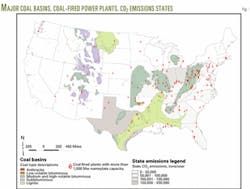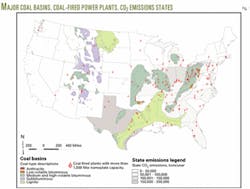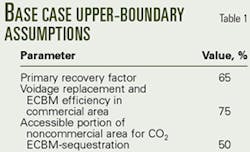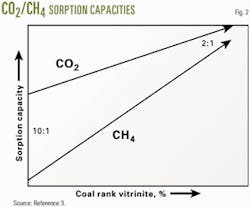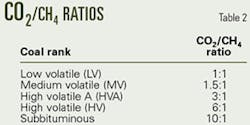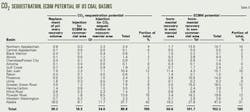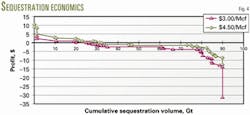Enhanced CBM recovery, coalbed CO2 sequestration assessed
Detailed reservoir studies of two enhanced coalbed methane recovery (ECBM) field projects in the San Juan basin of New Mexico provide an understanding of the reservoir mechanisms of carbon dioxide (CO2) and nitrogen (N2) injection into coalbeds, demonstrate the practical effectiveness of the ECBM and sequestration processes, and afford a basis for investigating the feasibility of CO2 sequestration in deep, unmineable coalbeds.
The studies were part of a multiyear government-industry research and development (R&D) collaboration, the Coal-Seq project, launched in October 2000 by the US Department of Energy (DOE) through its contractor Advanced Resources International (ARI).1
The two ECBM sites are the Allison Unit, operated by Burlington Resources Inc., and the Tiffany Unit, operated by BP America Inc. CO2 is being injected in the Allison Unit while N2 is being injected into the Tiffany Unit.
Understanding the N2-ECBM process has important implications for CO2 sequestration via flue-gas injection.
In addition, laboratory and theoretical studies in support of these efforts have provided an understanding for modeling multicomponent isotherm behavior and coal permeability changes due to swelling with CO2 injection.
Extrapolation of the findings from the San Juan basin to a national scale is the basis for this preliminary assessment of ECBM recovery and CO2 sequestration potential of US coalbeds.
IEA estimate
In 1998, the International Energy Agency Greenhouse Gas R&D Programme assessed the global potential for sequestering CO2 in coalbeds.2
The program estimated that the US could potentially sequester up to 35 gigatonnes (Gt) of CO2 in basins that included the San Juan, Uinta, Raton, Warrior, Northern and Central Appalachian, Powder River, Piceance, and Greater Green River.
This estimate, simply stated, assumed that CO2 replaces the total in-place methane resources at a 2:1 ratio. In addition, it estimated that CO2 -ECBM has a potential to recover 328 tcf of incremental methane.
This estimate essentially attributes the entire in-place methane resource as having a potential for ECBM recovery.
While this is a useful first-order estimate of sequestration and ECBM potential, analysis of the technical findings of the Coal-Seq project, specifically the results of both the field and laboratory studies, improve these estimates by incorporating:
- A more comprehensive list of US coal basins.
- Improved technical rationale for setting upper-boundary limits on the results.
- New information on CO2 -CH4 replacement ratios as a function of coal rank.
Methodology
The overall approach for determining a better estimate for the CO2 sequestration potential of US coals included three steps:
1.Determining the replacement of methane produced by primary production with CO2 in the commercial area, according to the coal rank from which that production is expected to occur. This step assumes that methane production creates a storage capacity voidage that can be replaced, up to the original coal reservoir pressure, by CO2. This scenario assumes that CO2 injection does not contribute to incremental methane recovery.
2.Determining the recovery of additional methane, unrecovered by primary production within the commercial area, as a result of CO2 injection, which creates additional voidage, and hence additional CO2 sequestration capacity.
3.Determining the recovery of additional methane via the CO2 -ECBM recovery process, and the additional CO2 sequestration capacity that is created in the noncommercial area. This area is considered technically less favorable of each basin for coalbed methane recovery and CO2 sequestration, but it is not favorable enough for commercial primary methane production.
Basin selection
Fig. 1 shows the major coal basins in the Lower 48 and major coal-fired power plants (>1,000 Mw nameplate capacity), as well as the states with high CO2 emissions.
This study included the following 17 basins or provinces:
- In the east, the Northern and Central Appalachian basins and the Warrior.
- In the Midcontinent, the Cherokee, Forest City, and Arkoma basins.
- The Gulf Coast basin because of the high volume of CO2 emissions in Texas.
- In the Rockies, the San Juan, Raton, Piceance, Uinta, Greater Green River, Hanna-Carbon, Wind River, and Powder River.
- In the west, the Western Washington basin because of an absence of other CO2 sequestration alternatives in that area.
- The vast coal and implied methane resources in Alaska (not shown in Fig. 1).
Upper-boundary limits
The study imposed key assumptions and discount factors to provide an improved rationale for upper-boundary limits on the assessment results. The approach first estimated reasonable values on a national-average basis and then applied adjustment factors for each basin as appropriate.
Key assumptions were:
- Primary recovery factor, which is the recovery factor in the commercial area for primary production. This parameter could be adjusted from the base case for high-rank coal settings where recovery factors tend to be less and for very deep coals where permeability loss could reduce recovery factors.
- Voidage-replacement and ECBM efficiency in commercial area, which is the efficiency of CO2 replacement for primary methane production in the commercial area.
Reasons for less than 100% replacement efficiency could include not wanting to pressurize the coal with CO2 to the original reservoir pressure (a possible issue in shallow coals), removal of the reservoir after methane production (in coal-mining areas), lack of surface access for CO2 injection (heavily populated areas), etc. This factor also is assumed to apply to ECBM recovery in the commercial area.
- Accessible portion of the noncommercial area for CO2 ECBM and sequestration, which is the amount of in-place methane resource in the non-commercial area that could be reasonably accessed for ECBM and sequestration purposes.
Reasons for limited access could include surface restrictions or reservoir constraints such as too deep or too shallow, too thin, too impermeable, etc. Conversely, areas with large volumes of CO2 emissions could have an increased level of accessibility due to the motivation to sequester CO2 near the source.
Table 1 presents the base-case assumptions for these parameters.
CO2 -to-CH4 replacement ratios
One of the key advancements this study provides over previous analyses is the incorporation of emerging information on how CO2 -to-CH4 replacement ratios change as a function of coal rank.
At the Coal-Seq I forum, Bustin conceptually presented sorption capacities for CO2 and CH4 as a function of coal rank (Fig. 2).3 His analysis suggests that the replacement ratio of CO2 -to-CH4 is highest for low- rank coals and decreases with increasing coal rank.
The high replacement ratios associated with low-rank coals have also been reported for samples from the Powder River and Gulf Coast basins.4
There is a void of publicly available data, however, to better quantify these relationships. Importantly, the generation of a quantitative relationship requires accurate coal rank information in addition to isotherm results, thus greatly reducing the public-domain data that can be used.
This study gathered and analyzed selected data to provide a foundation upon which such a relationship could be established and used for this assessment. Quantitative data were obtained from several sources, as follows:
- As part of the Coal-Seq project, CH4 and CO2 isotherm and coal rank data were obtained for San Juan basin coal from the Tiffany Unit.5
- Pashin also presented CO2 and CH4 isotherms at the Coal-Seq I forum.6 Langmuir coefficients and coal rank data were later published for those data.7
- For low-rank coals, Nelson published some coal isotherm and rank information from the Powder River basin.8
These sources provided four data points upon which to develop a relationship. While not an overwhelming amount of information, this may be the first quantitative presentation of its type and hence represents the start of what may become a growing body of information on this topic. Fig. 3 presents this relationship.
As expected, the figure indicates a trend of decreasing ratio with increasing coal rank. Quantitatively, the ratios are in the range of 10:1 for subbituminous coals, decreasing to 1:1 for low-volatile bituminous coal.
Based on this information, Table 2 presents the ratios used to compute the CO2 sequestration potential of US coalbeds in this study.
Study results
Table 3 summarizes the CO2 sequestration and ECBM potential by basin. In total, this potential is about 90 Gt for CO2 sequestration and 152 tcf for ECBM recovery.
To put the sequestration capacity estimate into perspective, total estimated CO2 emissions in the US in 2001 were 5.8 Gt.9 Of this, the electric power generation sector, the most likely source of CO2 for coalbed sequestration, emitted an estimated 2.2 Gt.
Coalbeds, therefore, have the capacity to sequester more than 40 years of CO2 from these sources at current levels of emission.
As a perspective for the ECBM potential, the US has a current estimated recoverable CBM resource of more than 170 tcf. ECBM could almost double this amount, which is already recognized as an essential component of the future US gas supply.
The major basins with CO2 sequestration potential are Alaska (42% or 38 Gt even after accounting for high costs associated with this province), Powder River (15% or 14 Gt), San Juan (12% or 10 Gt), and Greater Green River (9% or 8 Gt).
The major basins contributing to the ECBM potential include Alaska (31% or 47 tcf even after accounting for high costs associated with this province), Powder River basin (13% or 20 tcf), Greater Green River basin (12% or 19 tcf), San Juan basin (10% or 16 tcf), and Northern Appalachian basin (10% or 15 tcf).
It is also interesting to note that CO2 sequestration potential is greatest when replacing primary methane recovery, followed by sequestration in the non-commercial area.
ECBM potential also is greatest in the noncommercial area, presumably due to its large geographic size as compared to the commercial area.
The CO2 sequestration and ECBM potential of the commercial areas are small in comparison; however, this result does not consider economics.
Economics
The study computed economics at $3.00 and $4.50/Mcf wellhead gas prices. Fig. 4 presents the results.
It must be emphasized that these estimates assume a CO2 cost of zero. Any costs for CO2 capture and transportation to the field would have to be added to these values to reach a total-system CO2 capture, transportation, and sequestration cost.
That said, some conclusions that can be drawn from these results include:
- Gas price does impact the CO2 sequestration economics, with higher gas prices leading to lower net-sequestration costs.
- Between 25 and 30 Gt of CO2 can be sequestered at a profit and between 80 and 85 Gt can be sequestered at costs less than $5/ton.
- Several Rocky Mountain basins, including the San Juan, Raton, Powder River, and Uinta appear to hold the most favorable conditions for sequestration economics. The Gulf Coast and the Central Appalachian basin also appear to hold promise as economic sequestration targets, depending upon gas prices.
- In general, the noncommercial areas appear more favorable for sequestration economics than the commercial areas. This is because there is more in-place methane to recover in these setting. The commercial areas have already been largely depleted of methane.
Acknowledgments
This work was performed with US DOE funding under a project titled "Geologic Sequestration of CO2 in Deep, Unmineable Coalbeds: An Integrated Research and Commercial-Scale Field Demonstration Project" (DE-FC26-00NT40924). A copy of the full report for this study, more information on the project, and other related work by others can be found at www.coal-seq.com.
References
1. Reeves, S.R., "Geologic Sequestration of CO2 in Deep, Unmineable Coalbeds: An Integrated Research and Commercial-Scale Field Demonstration Project," Paper No. SPE 71749, SPE Annual Technical Conference and Exhibition, New Orleans, Sept. 30-Oct. 3, 2001.
2. Stevens, S.H., and Spector, D., Enhanced Coalbed Methane Recovery: Worldwide Application and CO2 Sequestration Potential, Final Report IEA/CONS/97/27, IEA Greenhouse Gas R&D Programme, 1998.
3. Bustin, M., "Research Activities on CO2, H2S and SO2 Sequestration at UBC," Coal-Seq I Forum, Houston, Mar. 14-15, 2002.
4. Stanton, R., et al., "Coal Bed Sequestration of Carbon Dioxide," DOE's First National Conference on Carbon Sequestration, Washington DC, May 14-17, 2001.
5. Gasem, K.A.M., Robinson, R.L., and Reeves, S.R., Adsorption of Pure Methane, Nitrogen, and Carbon Dioxide and Their Mixtures on San Juan Basin Coal, DOE Topical Report, Contract No. DE-FC26-00NT40924, May 2002.
6. Pashin, J, "Temperature – Pressure Conditions and Coal Quality in the Black Warrior Basin: Implications for CO2 Sequestration," Coal-Seq I Forum, Houston, Mar. 14-15, 2002.
7. Pashin, J.C., et al., Geologic Screening Criteria for Sequestration of CO2 in Coal: Quantifying Potential of the Black Warrior Coalbed Methane Fairway, Alabama, Annual Technical Progress Report, DOE, National Technology Laboratory, Contract No. DE-FC-00NT40927.
8. Nelson, C.R., Hill, D.G., and Pratt, T.J, "Properties of Paleocene Fort Union Formation Canyon Seam Coal at the Triton Federal Coalbed Methane Well, Campbell County, Wyoming," Paper No. SPE 59786, CERI/SPE Gas Technology Symposium, Calgary, Apr. 3-5, 2000.
9. Emissions of Greenhouse Gases in the United States, 2001, DOE/EIA-0573 (2001), Energy Information Agency, December 2002.
The author
Scott Reeves ([email protected]) is executive vice-president of Advanced Resources International Inc., Houston. Reeves holds a BS in petroleum engineering from Texas A&M University and an MBA from Duke University.
